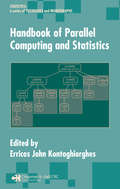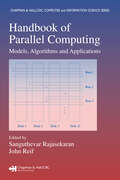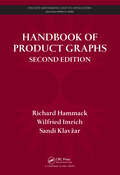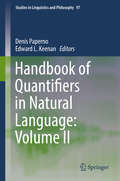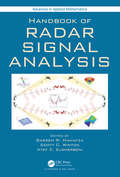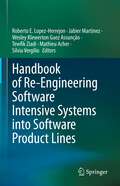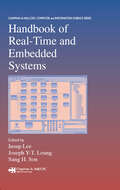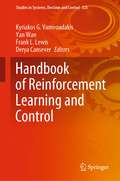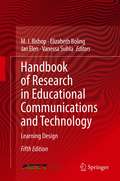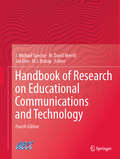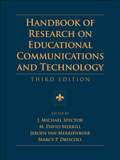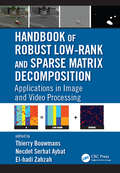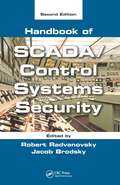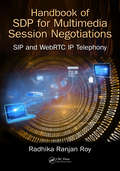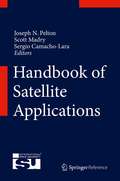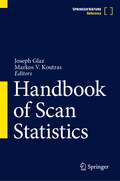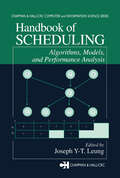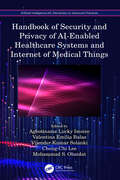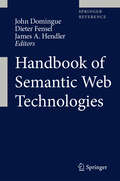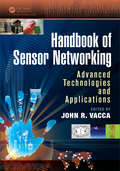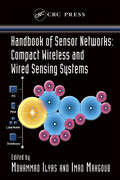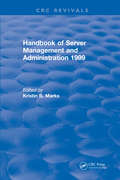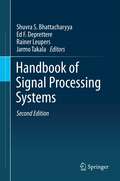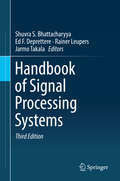- Table View
- List View
Handbook of Parallel Computing and Statistics (Statistics: A Series of Textbooks and Monographs)
by Erricos John KontoghiorghesTechnological improvements continue to push back the frontier of processor speed in modern computers. Unfortunately, the computational intensity demanded by modern research problems grows even faster. Parallel computing has emerged as the most successful bridge to this computational gap, and many popular solutions have emerged based on its concepts
Handbook of Parallel Computing: Models, Algorithms and Applications (Chapman & Hall/CRC Computer and Information Science Series)
by Sanguthevar Rajasekaran John ReifThe ability of parallel computing to process large data sets and handle time-consuming operations has resulted in unprecedented advances in biological and scientific computing, modeling, and simulations. Exploring these recent developments, the Handbook of Parallel Computing: Models, Algorithms, and Applications provides comprehensive coverage on a
Handbook of Practical Logic and Automated Reasoning
by John HarrisonThe sheer complexity of computer systems has meant that automated reasoning, i. e. the ability of computers to perform logical inference, has become a vital component of program construction and of programming language design. This book meets the demand for a self-contained and broad-based account of the concepts, the machinery and the use of automated reasoning. The mathematical logic foundations are described in conjunction with practical application, all with the minimum of prerequisites. The approach is constructive, concrete and algorithmic: a key feature is that methods are described with reference to actual implementations (for which code is supplied) that readers can use, modify and experiment with. This book is ideally suited for those seeking a one-stop source for the general area of automated reasoning. It can be used as a reference, or as a place to learn the fundamentals, either in conjunction with advanced courses or for self study.
Handbook of Product Graphs (Discrete Mathematics and Its Applications)
by Richard Hammack Wilfried Imrich Sandi KlavžarThis handbook examines the dichotomy between the structure of products and their subgraphs. It also features the design of efficient algorithms that recognize products and their subgraphs and explores the relationship between graph parameters of the product and factors. Extensively revised and expanded, this second edition presents full proofs of many important results as well as up-to-date research and conjectures. It illustrates applications of graph products in several areas and contains well over 300 exercises. Supplementary material is available on the book's website.
Handbook of Quantifiers in Natural Language: Volume II
by Denis Paperno Edward L. KeenanThis work presents the structure, distribution and semantic interpretation of quantificational expressions in languages from diverse language families and typological profiles. The current volume pays special attention to underrepresented languages of different status and endangerment level. Languages covered include American and Russian Sign Languages, and sixteen spoken languages from Africa, Australia, Papua, the Americas, and different parts of Asia. The articles respond to a questionnaire the editors constructed to enable detailed crosslinguistic comparison of numerous features. They offer comparable information on semantic classes of quantifiers (generalized existential, generalized universal, proportional, partitive), syntactically complex quantifiers (intensive modification, Boolean compounds, exception phrases, etc. ), and several more specific issues such as quantifier scope ambiguities, floating quantifiers, and binary (type 2) quantifiers. The book is intended for semanticists, logicians interested in quantification in natural language, and general linguists as articles are meant to be descriptive and theory independent. The book continues and expands the coverage of the Handbook of Quantifiers in Natural Language (2012) by the same editors, and extends the earlier work in Matthewson (2008), Gil et al. (2013) and Bach et al (1995).
Handbook of Radar Signal Analysis (Advances in Applied Mathematics)
by Bassem R. MahafzaThis new handbook on radar signal analysis adopts a deliberate and systematic approach. It uses a clear and consistent level of delivery while maintaining strong and easy-to-follow mathematical details. The emphasis of this book is on radar signal types and their relevant signal processing and not on radar systems hardware or components. This handbook serves as a valuable reference to a wide range of audience. More specifically, college-level students, practicing radar engineers, as well as casual readers of the subject are the intended target audience of the first few chapters of this book. As the book chapters progress, these grow in complexity and specificity. Accordingly, later chapters are intended for practicing engineers, graduate college students, and advanced readers. Finally, the last few chapters contain several special topics on radar systems that are both educational and scientifically entertaining to all readers. The presentation of topics in this handbook takes the reader on a scientific journey whose major landmarks comprise the different radar subsystems and components. In this context, the chapters follow the radar signal along this journey from its birth to the end of its life. Along the way, the different relevant radar subsystems are analyzed and discussed in great detail. The chapter contributors of this new handbook comprise experienced academia members and practicing radar engineers. Their combined years of academic and real-world experiences are in excess of 175. Together, they bring a unique, easy-to-follow mix of mathematical and practical presentations of the topics discussed in this book. See the "Chapter Contributors" section to learn more about these individuals.
Handbook of Re-Engineering Software Intensive Systems into Software Product Lines
by Roberto E. Lopez-Herrejon Jabier Martinez Wesley Klewerton Guez Assunção Tewfik Ziadi Mathieu Acher Silvia VergilioThis handbook distils the wealth of expertise and knowledge from a large community of researchers and industrial practitioners in Software Product Lines (SPLs) gained through extensive and rigorous theoretical, empirical, and applied research. It is a timely compilation of well-established and cutting-edge approaches that can be leveraged by those facing the prevailing and daunting challenge of re-engineering their systems into SPLs. The selection of chapters provides readers with a wide and diverse perspective that reflects the complementary and varied expertise of the chapter authors. This perspective covers the re-engineering processes, from planning to execution.SPLs are families of systems that share common assets, allowing a disciplined software reuse. The adoption of SPL practices has shown to enable significant technical and economic benefits for the companies that employ them. However, successful SPLs rarely start from scratch, but instead, they usually start from a set of existing systems that must undergo well-defined re-engineering processes to unleash new levels of productivity and competitiveness.Practitioners will benefit from the lessons learned by the community, captured in the array of methodological and technological alternatives presented in the chapters of the handbook, and will gain the confidence for undertaking their own re-engineering challenges. Researchers and educators will find a valuable single-entry point to quickly become familiar with the state-of-the-art on the topic and the open research opportunities; including undergraduate, graduate students, and R&D engineers who want to have a comprehensive understanding of techniques in reverse engineering and re-engineering of variability-rich software systems.
Handbook of Real-Time and Embedded Systems (Chapman & Hall/CRC Computer and Information Science Series)
by Insup Lee Joseph Y-T. Leung Sang H. SonReal-time and embedded systems are essential to our lives, from controlling car engines and regulating traffic lights to monitoring plane takeoffs and landings to providing up-to-the-minute stock quotes. Bringing together researchers from both academia and industry, the Handbook of Real-Time and Embedded Systems provides comprehensive covera
Handbook of Reinforcement Learning and Control (Studies in Systems, Decision and Control #325)
by Frank L. Lewis Kyriakos G. Vamvoudakis Yan Wan Derya CanseverThis handbook presents state-of-the-art research in reinforcement learning, focusing on its applications in the control and game theory of dynamic systems and future directions for related research and technology.The contributions gathered in this book deal with challenges faced when using learning and adaptation methods to solve academic and industrial problems, such as optimization in dynamic environments with single and multiple agents, convergence and performance analysis, and online implementation. They explore means by which these difficulties can be solved, and cover a wide range of related topics including:deep learning;artificial intelligence;applications of game theory;mixed modality learning; andmulti-agent reinforcement learning.Practicing engineers and scholars in the field of machine learning, game theory, and autonomous control will find the Handbook of Reinforcement Learning and Control to be thought-provoking, instructive and informative.
Handbook of Research in Educational Communications and Technology: Learning Design
by Jan Elen M. J. Bishop Elizabeth Boling Vanessa SvihlaThe 5th edition of the prestigious AECT Handbook continues previous efforts to reach outside the traditional instructional design and technology community to the learning sciences and computer information systems communities toward developing a conceptualization of the field. However, given the pervasive and increasingly complex role technology now plays in education since the 1st edition of the Handbook in 1996, the editors have reorganized the research chapters in this edition to focus on the learning problems we are trying to solve with educational technologies, rather than to focus on the things we are using to solve those problems. Additionally, for the first time this edition of the Handbook reflects our field’s growing understanding of the importance of design scholarship to inform practice by including design case chapters. These changes for this edition of the Handbook are intended to bring educational technology research into the broader framework of educational research by elaborating on the role instructional design and technology plays as a scholarly discipline in addressing education’s increasingly complex issues.Provides comprehensive reviews of new developments in educational technology research and design practice.Includes concrete examples to guide future research and practice in the ways emerging technologies can be used to solve educational problems.Contains extensive references furnished to guide readers to the most recent research and design practice in the field of instructional design and technology.
Handbook of Research on Educational Communications and Technology
by J. Michael Spector M. David Merrill Jan Elen M. J. BishopThe 4th edition of the Handbook of Research on Educational Communications and Technology expands upon the previous 3 versions, providing a comprehensive update on research pertaining to new and emerging educational technologies. Chapters that are no longer pertinent have been eliminated in this edition, with most chapters being completely rewritten, expanded, and updated Additionally, new chapters pertaining to research methodologies in educational technology have been added due to expressed reader interest. Each chapter now contains an extensive literature review, documenting and explaining the most recent, outstanding research, including major findings and methodologies employed. The Handbook authors continue to be international leaders in their respective fields; the list is cross disciplinary by design and great effort was taken to invite authors outside of the traditional instructional design and technology community.
Handbook of Research on Educational Communications and Technology: A Project of the Association for Educational Communications and Technology (AECT Series #2)
by J. Michael Spector M. David Merrill Marcy P. Driscoll Jeroen Van MerriËNboerFirst Published in 2008. Routledge is an imprint of Taylor & Francis, an informa company.
Handbook of Robust Low-Rank and Sparse Matrix Decomposition: Applications in Image and Video Processing
by Thierry Bouwmans, Necdet Serhat Aybat and El-hadi ZahzahHandbook of Robust Low-Rank and Sparse Matrix Decomposition: Applications in Image and Video Processing shows you how robust subspace learning and tracking by decomposition into low-rank and sparse matrices provide a suitable framework for computer vision applications. Incorporating both existing and new ideas, the book conveniently gives you one-stop access to a number of different decompositions, algorithms, implementations, and benchmarking techniques. Divided into five parts, the book begins with an overall introduction to robust principal component analysis (PCA) via decomposition into low-rank and sparse matrices. The second part addresses robust matrix factorization/completion problems while the third part focuses on robust online subspace estimation, learning, and tracking. Covering applications in image and video processing, the fourth part discusses image analysis, image denoising, motion saliency detection, video coding, key frame extraction, and hyperspectral video processing. The final part presents resources and applications in background/foreground separation for video surveillance. With contributions from leading teams around the world, this handbook provides a complete overview of the concepts, theories, algorithms, and applications related to robust low-rank and sparse matrix decompositions. It is designed for researchers, developers, and graduate students in computer vision, image and video processing, real-time architecture, machine learning, and data mining.
Handbook of SCADA/Control Systems Security
by Burt G. LookThis comprehensive handbook covers fundamental security concepts, methodologies, and relevant information pertaining to supervisory control and data acquisition (SCADA) and other industrial control systems used in utility and industrial facilities worldwide. Including six new chapters, six revised chapters, and numerous additional figures, photos, and illustrations, it addresses topics in social implications and impacts, governance and management, architecture and modeling, and commissioning and operations. It presents best practices as well as methods for securing a business environment at the strategic, tactical, and operational levels.
Handbook of SDP for Multimedia Session Negotiations: SIP and WebRTC IP Telephony
by Radhika Ranjan RoyThis book on SDP is the first of this kind that attempts to put all SDP related RFCs together with their mandatory and optional texts in a chronological systematic way as if people can use a single “super-SDP RFC” with almost one-to-one integrity from beginning to end to see the big picture of SDP in addition to base SDP functionalities.
Handbook of Satellite Applications
by Sergio Camacho-Lara Scott Madry Joseph N. PeltonTop space experts from around the world have collaborated to produce this comprehensive, authoritative, and clearly illustrated reference guide to the fast growing, multi-billion dollar field of satellite applications and space communications. This handbook, done under the auspices of the International Space University based in France, addresses not only system technologies but also examines market dynamics, technical standards and regulatory constraints. The handbook is a completely multi-disciplinary reference book that covers, in an in-depth fashion, the fields of satellite telecommunications, Earth observation, remote sensing, satellite navigation, geographical information systems, and geosynchronous meteorological systems. It covers current practices and designs as well as advanced concepts and future systems. It provides a comparative analysis of the common technologies and design elements for satellite application bus structures, thermal controls, power systems, stabilization techniques, telemetry, command and control (TTC), and orbital configurations. These common aspects are addressed in an integrated fashion to explain how all these space systems share similar design features, but also have quite specialized application packages to carry out their various missions. No other reference in print today provides such a comprehensive and in-depth guide to all forms of application satellites, including small sats as used by countries just beginning space application programs.
Handbook of Scan Statistics
by Joseph Glaz Markos V. KoutrasScan statistics, one of the most active research areas in applied probability and statistics, has seen a tremendous growth during the last 25 years. Google Scholar lists about 3,500 hits to references of articles on scan statistics since the year 2020, resulting in over 850 hits to articles per year. This is mainly due to extensive and diverse areas of science and technology where scan statistics have been employed, including: atmospheric and climate sciences, business, computer science, criminology, ecology, epidemiology, finance, genetics and genomics, geographic sciences, medical and health sciences, nutrition, pharmaceutical sciences, physics, quality control and reliability, social networks and veterinary science. This volume of the Handbook of Scan Statistics is a collection of forty chapters, authored by leading experts in the field, outlines the research and the breadthof applications of scan statistics to the numerous areas of science and technology listed above. These chapters present an overview of the theory, methods and computational techniques, related to research in the area of scan statistics and outline future developments. It contains extensive references to research articles, books and relevant computer software. Handbook of Scan Statistics is an excellent reference for researchers and graduate students in applied probability and statistics, as well as for scientists in research areas where scan statistics are used. This volume may also be used as a textbook for a graduate level course on scan statistics.
Handbook of Scheduling: Algorithms, Models, and Performance Analysis (Chapman & Hall/CRC Computer and Information Science Series)
by Joseph Y-T. LeungThis handbook provides full coverage of the most recent and advanced topics in scheduling, assembling researchers from all relevant disciplines to facilitate new insights. Presented in six parts, these experts provides introductory material, complete with tutorials and algorithms, then examine classical scheduling problems. Part 3 explores scheduling models that originate in areas such as computer science, operations research. The following section examines scheduling problems that arise in real-time systems. Part 5 discusses stochastic scheduling and queueing networks, and the final section discusses a range of applications in a variety of areas, from airlines to hospitals.
Handbook of Security and Privacy of AI-Enabled Healthcare Systems and Internet of Medical Things (ISSN)
by Mohammad S. Obaidat Valentina Emilia Balas Vijender Kumar Solanki Agbotiname Lucky Imoize Cheng-Chi LeeThe fast-growing number of patients suffering from various ailments has overstretched the carrying capacity of traditional healthcare systems. This handbook addresses the increased need to tackle security issues and preserve patients’ privacy concerns in Artificial Intelligence of Medical Things (AIoMT) devices and systems.Handbook of Security and Privacy of AI-Enabled Healthcare Systems and the Internet of Medical Things provides new insights into the deployment, application, management, and benefits of AIoMT by examining real-world scenarios. The handbook takes a critical look at existing security designs and offers solutions to revamp traditional security architecture, including the new design of effi cient intrusion detection algorithms, attack prevention techniques, and both cryptographic and noncryptographic solutions. The handbook goes on to discuss the critical security and privacy issues that affect all parties in the healthcare ecosystem and provides practical AI-based solutions.This handbook offers new and valuable information that will be highly beneficial to educators, researchers, and others.
Handbook of Semantic Web Technologies
by Dieter Fensel James A. Hendler John DomingueAfter years of mostly theoretical research, Semantic Web Technologies are now reaching out into application areas like bioinformatics, eCommerce, eGovernment, or Social Webs. Applications like genomic ontologies, semantic web services, automated catalogue alignment, ontology matching, or blogs and social networks are constantly increasing, often driven or at least backed up by companies like Google, Amazon, YouTube, Facebook, LinkedIn and others. The need to leverage the potential of combining information in a meaningful way in order to be able to benefit from the Web will create further demand for and interest in Semantic Web research. This movement, based on the growing maturity of related research results, necessitates a reliable reference source from which beginners to the field can draw a first basic knowledge of the main underlying technologies as well as state-of-the-art application areas. This handbook, put together by three leading authorities in the field, and supported by an advisory board of highly reputed researchers, fulfils exactly this need. It is the first dedicated reference work in this field, collecting contributions about both the technical foundations of the Semantic Web as well as their main usage in other scientific fields like life sciences, engineering, business, or education.
Handbook of Sensor Networking: Advanced Technologies and Applications
by John R. VaccaThis handbook provides a complete professional reference and practitioner's guide to today's advanced sensor networking technologies. It focuses on both established and recent sensor networking theory, technology, and practice. Specialists at the forefront of the field address immediate and long-term challenges and explore practical solutions to a wide range of sensor networking issues. The book covers the hardware of sensor networks, wireless communication protocols, sensor networks software and architectures, wireless information networks, data manipulation, signal processing, localization, and object tracking through sensor networks.
Handbook of Sensor Networks: Compact Wireless and Wired Sensing Systems
by Imad Mahgoub Mohammad IlyrasAs the field of communications networks continues to evolve, the challenging area of wireless sensor networks is rapidly coming of age. Recent advances have made it possible to make sensor components more compact, robust, and energy efficient than ever, earning the idiosyncratic alias ofSmart Dust. Production has also improved, yielding larger,
Handbook of Server Management and Administration: 1999
by Kristin B. MarksServers are the heart of the network. The Handbook of Server Management and Administration keeps you up-to-date with the very latest server technology and gives you the tools you need to choose, configure and maintain a server that will serve users, data streams and corporate goals with equal efficiency. The practical tips and case studies you'll find in the Handbook include detailed explanations of:the case for mainframe servers in the enterpriseserver installation considerationsserver security policiesserver data bus standardsmigrating to NetWare 4.1 and Novell Directory ServicesWindows NT Workstation vs. Server 4.0UNIX as an application serverfax serversInternet e-mail servers the art of placing images and multimedia on the corporate networkand more!The contributing authors to the Handbook of Server Management and Administration are industry experts. Some work at corporations that have designed innovative solutions. Some wear battle scars from the field. Many are experienced writers and public speakers. All of them know what they're talking about. These leading authorities give you a wealth of practical advice, tips and strategies on how to:evaluate anti-virus solutions within distributed environmentsset up fault tolerance protection and RAID technology for networkschoose the best network data and storage management techniques
Handbook of Signal Processing Systems
by Rainer Leupers Ed F. Deprettere Jarmo Takala Shuvra S. BhattacharyyaHandbook of Signal Processing Systems is organized in three parts. The first part motivates representative applications that drive and apply state-of-the art methods for design and implementation of signal processing systems; the second part discusses architectures for implementing these applications; the third part focuses on compilers and simulation tools, describes models of computation and their associated design tools and methodologies. This handbook is an essential tool for professionals in many fields and researchers of all levels.
Handbook of Signal Processing Systems
by Rainer Leupers Ed F. Deprettere Jarmo Takala Shuvra S. BhattacharyyaIn this new edition of the Handbook of Signal Processing Systems, many of the chapters from the previous editions have been updated, and several new chapters have been added. The new contributions include chapters on signal processing methods for light field displays, throughput analysis of dataflow graphs, modeling for reconfigurable signal processing systems, fast Fourier transform architectures, deep neural networks, programmable architectures for histogram of oriented gradients processing, high dynamic range video coding, system-on-chip architectures for data analytics, analysis of finite word-length effects in fixed-point systems, and models of architecture. There are more than 700 tables and illustrations; in this edition over 300 are in color. This new edition of the handbook is organized in three parts. Part I motivates representative applications that drive and apply state-of-the art methods for design and implementation of signal processing systems; Part II discusses architectures for implementing these applications; and Part III focuses on compilers, as well as models of computation and their associated design tools and methodologies.
